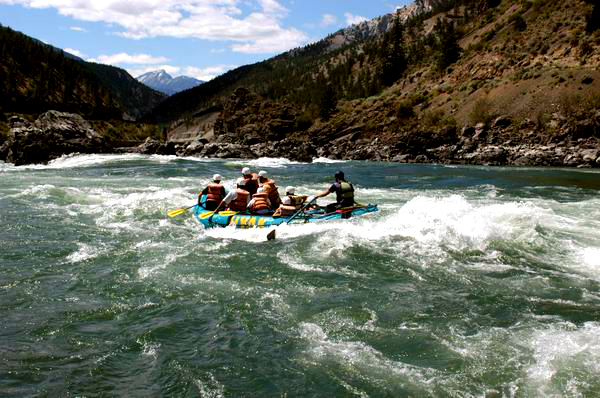
White
Water
by
Phil Maranda
)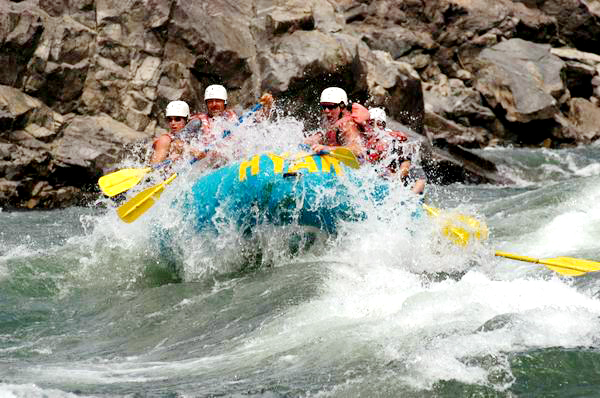
The rapids are close; I can feel it…in the river’s quickening
pulse and the quiet apprehension of the rafters but most of all deep down
in my gut. There are other signs too. The air seems tense, heavy, like
the prelude to the gathering of an electrical storm. And to my mind’s
eye, the giant boulders sitting plump on the banks of the river resemble
a thousand stone Buddha’s all pointing towards the uncertain future
that awaits us downstream. Up ahead lies Hell’s Gate Canyon—a
wild, unpredictable section of the mighty Fraser River where the water
has been forced into utter madness.
Lincoln pull-starts the tiny outboard motor on the back of our raft—we’ll
need it shortly to give us at least some control—and focuses his
narrowed, blazing eyes on the approaching turmoil. The tug on the raft
steadily increases, and the first whitecaps begin to slap hard on the
sides of the tubing. Directly in front of our J-rig, the caramel-colored
water funnels between vertical cliffs, and the river churns into a mass
chaos of enormous whirlpools, boils, and waves. Now, as the thundering
roar of the water becomes deafening, a chilly spray reaches over the bow,
and while everyone hangs on for dear life, we begin to plunge into the
explosive surge of Hell’s Gate….
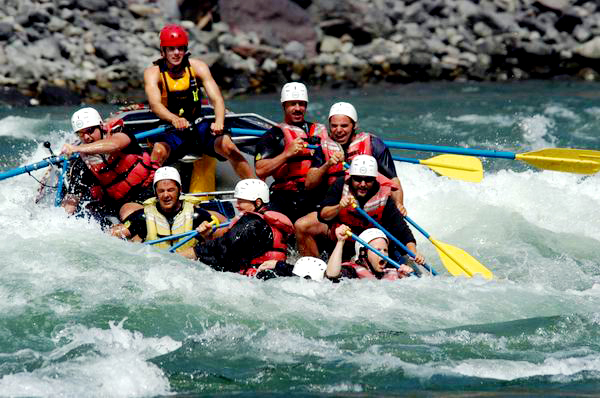
On the first day of my adventure, I found myself standing on the edge
of a high mountain lake listening intently to Linnea Mawer, a Fraser River
Raft Expedition’s guide, as she explained what to do if we failed
to grab the perimeter line (also referred to as the “Oh-shit line”
by the guides) and fell out of the boat. “When you are doing the
defensive swimming position, try to keep your feet pointed downstream
with both of your legs held tightly together. If you spread your legs
and hit something, you’ll get more of a thrill than you’re
looking for today,” she said smiling. She continued, mentioning
that the defensive swimming position gives us time to make a decision
on how we can safely get out of the water. And before Linnea finished
her speech, she covered 60 points on how to survive the white-water river
we were about to run.
)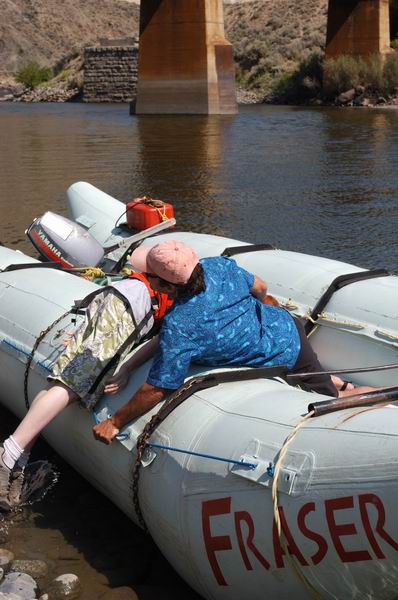
Twenty minutes later, we donned our life jackets, piled into the paddle
rafts, and headed out on Francis Lake for our on-the-water orientation.
Wes Wilhelm, our boatman for the upcoming river, quickly informed the
group that we’d have to hit the water. He explained that it is safer
to experience the shock of the icy cold wet stuff in the lake instead
of while struggling to get back into the boat once on the river. I was
the first to volunteer. “It’s better to get this over with,”
I told myself then leaped into the glacier-fed lake. The shock—even
in a wet suit—feels like being shot in the chest with a small caliber
rifle. Gasping for air and taking in water, I surfaced just in time to
be hauled into the boat still in one piece. Bonie Choris, a housewife
from Medford, Wisconsin, went next followed by her son, Tom, with Minister
Bob Choris last. Everyone came out of it a-okay, a little shaken and stirred
but no worse for wear. Our team was then put through a series of paddle
drills, and when Wes was satisfied that we knew more than we did before
signing the waivers at the office earlier that day, we picked up guide
Sean Muldoon, got the “forward paddle” command, and headed
towards the Nahatlatch River.
)large.jpg)
At the end of Francis Lake, the river dropped suddenly. Our tiny 14-foot
raft hit the first waves of Anticipation Rapids, and we were yanked into
the churning turmoil. Wes was shouting commands, we were paddling like
crazy, and the Nahatlatch was taking the boat where it wanted it to go.
Our raft bounced from one swell to the next, and water exploded in all
directions as we passed within a few feet of the massive boulders that
peppered the river.
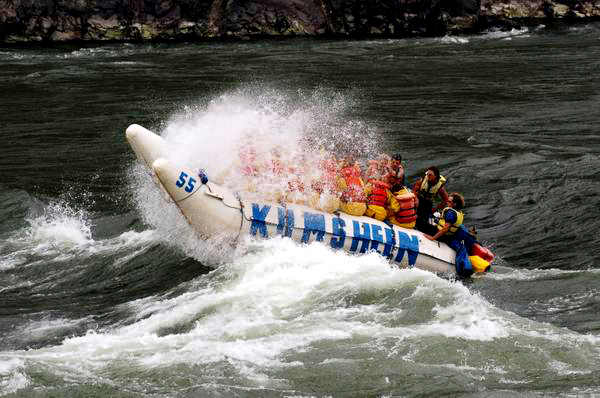
Sitting at the bow, Tom and I led the charge out of the first set of rapids
into the Rose Garden—a strip of white water that any sane person
would only want to encounter from shore. Immediately its surge enveloped
the raft, icy water soaking our brave crew. Then without warning, we were
pulled into a re-circulating hole, the river suspending our forward momentum
for only a moment before spitting us out. Through one wave after another,
we tackled the class IV rapids, dropping 140 feet before we were done.
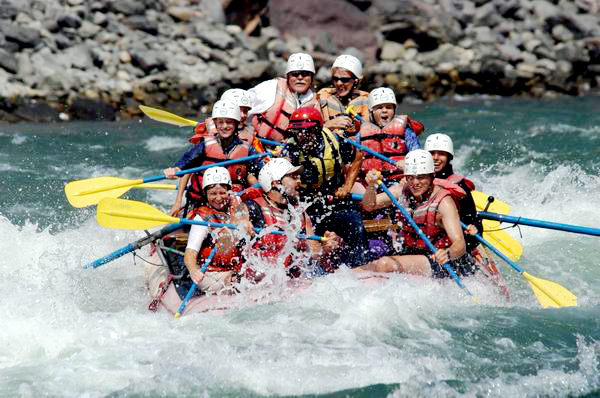
Seconds later, I struggled to see where the river was leading and could
barely make out the next set of rapids—The Meat-grinder. Wes yelled
above the thundering roar of the water, “Hold on! Get down!”
It was too late. Our raft plummeted out of control into a section of river
gone mad. The Meat-grinder grabbed the boat, pulling us forward, then
as quickly as it began, our advance abruptly ended; we were trapped in
another hole. The back of our raft instantly disappeared, blanketed by
the river. Wes was up to his knees in water when he croaked, “Forward
paddle. Hard!” The crew dug in, pulling us out.
Surviving the Meat-grinder built confidence, and we tackled the next set
of rapids like white-water pros—digging in, meeting each wave with
a paddle stroke, and even taking time to scream “YEE HAH!”
as we crested the whitecaps. Just when I thought we could make it through
anything, we lost rookie guide, Sean Muldoon, over the side. Before anyone
could react, he was in the water and out again, scrambling into the boat,
hitting the bottom of the raft like a landed fish. At first I wondered
if somehow I had knocked Sean overboard, but he assured me that I had
nothing to do with it; the same thing happened to him last week.
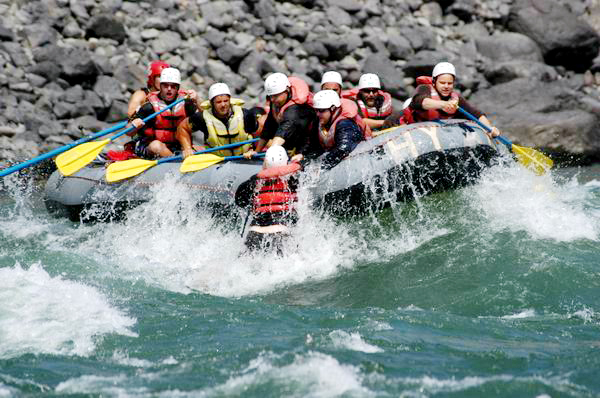
One set of rapids spilled into the next, and before long we were coasting
towards the take-out point on the river. Battered and tired but not beaten,
I emerged from my first white-water rafting experience looking forward
to doing it again.
Next day we power-rafted the Thompson, a large volume (up to 4,500 cms,
cubic meters per second), emerald-colored river that snakes through one
of Canada’s truly unique desert environments. Over 30 rapids with
names like Devil’s Kitchen, The Cauldron, and the Jaws of Death
lie in-between the put-in site and the Fraser—over 25 miles of incredible
white-water.
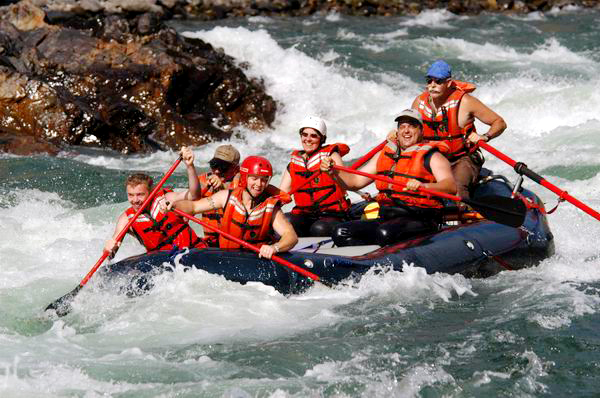
The Thompson became the first white-water river in British Columbia to
be commercially rafted in the summer of 1973, and to this day is still
one of the province’s biggest draws. Adventurers can choose from
three boat designs for this popular trip: motorized J-rigged rafts, paddle,
or oar. The J-rigs are giant vessels with 28-foot long tubes made of World
War II bridge pontoons. Forty-horsepower motors allow the rafts to be
maneuvered into the best rapids and can be used to carry enthusiasts upstream
to re-run the same white-water several times. These versatile vessels
can also be specially set up to run different volume rivers, and on the
Fraser, two extra pontoons are added to increase stability in the gigantic
waves, whirlpools, and boils which are found there.
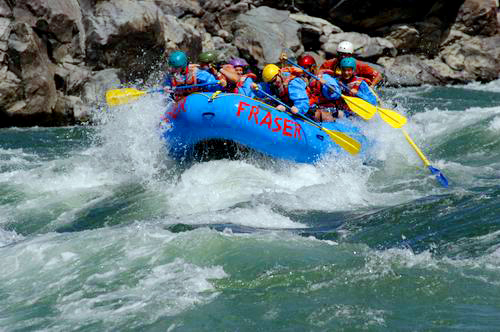
“Lets go!” called Lincoln, and our band of brave rafters slid
into position over the big tubing of the J-rig. Pushing off from the shore,
we drifted out into the open river and instantly became fair game for
the paddle rafters who had moved in, chopping at the water with their
paddles. They attacked us mercilessly even though we were unarmed, and
without the motor turned on, unable to escape. Gallons of water rained
down as Lincoln scrambled to pull-start the engine. Too late! By the time
we were under power, everyone on our raft had experienced the icy water
of the Thompson River without falling out of the boat.
Once safely ahead of the paddle rafts, Lincoln shut off the motor, and
as we drifted downstream, I marveled at the contrast between the chilly
water and the hot, dry, sage-covered banks of the river. Rounding a curve,
we came across a group of California bighorn sheep playing follow-the-leader
as they leapt off a dusty hillside only to scramble back up again. “If
our raft had this kind of agility earlier,” I thought to myself,
“we could have avoided a real soaking.”
Further down, a black bear headed for the safety of the bush as we sailed
by, and a bald eagle soared overhead on warm air currents that were rising
from the valley floor. I almost forgot why we were here, and then a familiar
sound reached my ears: the gentle rumble of rapids in the distance.
Back on the power, Lincoln lined up the boat to hit the Bighorn Rapids
straight on. Cresting the first roller, the boat suddenly dropped, then
rose up the second wave with increased speed, launching the bow of our
raft 15 feet into the air. The group screamed in unison as the next wave
erupted over the forward tubing, turning the J-rig into a submarine. Somehow
everyone hung on, and moments later, we were through the first set of
rapids on the Thompson.
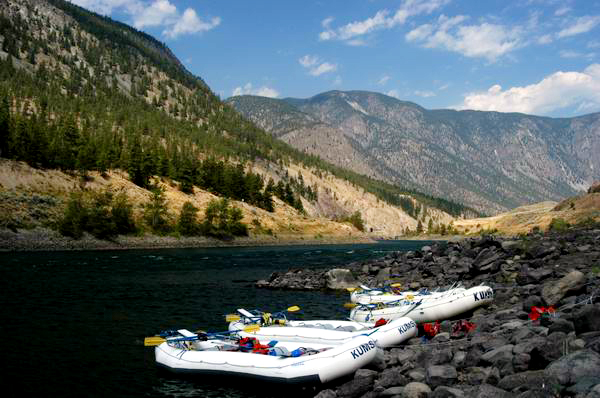
By the time we stopped for lunch, the crew was
ready for the break; we’d tackled some of the largest rapids on
the river practically one after another for over an hour. The guides went
to work preparing gourmet sandwiches and iced tea while I took advantage
of the time-out by sitting in the shade of a gently swaying tree trying
to catch my breath.
We set out again with full bellies; I immediately volunteered to sit at
the front of the raft for the remainder of the trip down the Thompson.
As we drew near a wicked series of rapids appropriately named The Cauldron,
Lincoln scanned either side of a giant boulder that splits the river in
two, creating a funnel-effect on both sides. All I could see was white,
boiling water, but somehow he read the river perfectly, and our J-rig
shot
)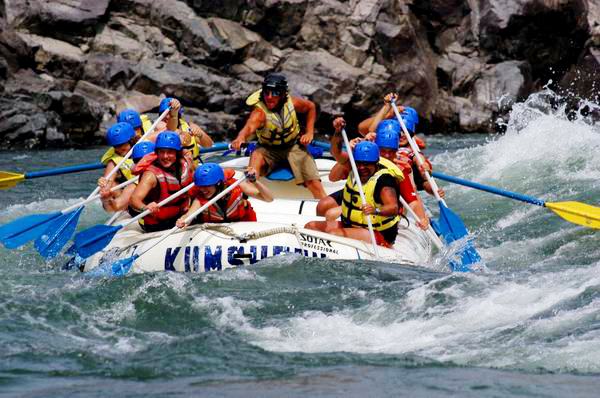
through the rapids like a roller-coaster car on straight tracks. He then
guided our raft to the edge of the river where we stopped to watch the
paddlers challenge the white water, each boat briefly disappearing from
view as they were swallowed by the river, and then reappearing seconds
later. Slapping their paddles together in a high-five, the excited rafters
gave the “We made it!” war cry before continuing downstream.
It was late afternoon when our rafts reached the mouth of the Thompson,
its brightly-colored water mixing with the muddy Fraser. Resting on a
sand bar, we loaded the J-rigs with gear and prepared for the final leg
of the day’s journey—a gentle float down a peaceful section
of the Fraser River to our camp site.
Under sapphire-blue skies, we drifted past jagged canyon walls that were
carved by the river millions of years before the first explorer dared
to venture there. And within a few miles, the landscape at the water’s
edge changed dramatically from the sagebrush of the desert to a variety
of evergreens that lined the banks and cast long shadows across the water.
With the sun beginning to set, we rounded a couple more bends in the river,
then the rafts eddied out of the current and landed safely on a rocky
shoreline below a grass-covered field where we would camp for the night.
.jpg)
After setting up the tents, a true feast, skillfully prepared by the multi-talented
river guides, awaited our group. I settled into a meal of chicken, corn,
and mixed vegetables all cooked over the open flames. Plenty of wine accompanied
our dinner, and before long, campfire songs echoed off the canyon walls
as darkness fell on the mighty Fraser.
Looking for a place away from the light of the fire, I wandered down to
the river where the rafts were floating on shimmering water lit by a million
stars. The Fraser seemed quiet at night. Calm. Peaceful. Deceiving! Lying
on a J-rig, I gazed sleepy-eyed at the Milky Way as it stretched into
eternity across a cloudless sky. Beneath my limp body, the coursing water
gently rocked me closer to dreamland while I listened to tiny waves making
slapping sounds on the rubber tubing. Tomorrow we’d tackle Hell’s
Gate!

Tightening my grip on the perimeter line, I prepare for our assault on
Hell’s Gate. Adrenaline begins racing through my blood as fast as
the raging river. Lincoln, our up until now, calm and collected Aussie
guide, has a look in his eyes like a Japanese Kamikaze pilot as he revs
the motor and heads into the surging white-water under full steam. Giant
waves instantly grab our raft, dragging us into the heart of the churning,
twisting chaos. The roar of the river drowns out any shrieks or cries
that may escape from the now closely huddled rafters as they hold on for
dear life. Hitting a massive wave suddenly throws muddy water into the
boat, temporarily covering our raft. Unable to see but still very much
aware that our 28-foot raft is being tossed in the rapids like a rag doll
in a washing machine, I resolve, “This is it, we’re going
to the bottom.”
Moments later, as the raft finally clears the last waves, I slowly open
my eyes and breathe a long sigh of relief; I’ve lived through Hell’s
Gate. Lincoln graciously points our raft upstream so we can view the carnage
that makes up the biggest rapids on one of the largest volume (up to 10,000
cms during high water), commercially rafted rivers on the planet.
When it’s time to go, our J-rig veers off and heads downstream.
I glance back to marvel again at the raw power of the river—a river
that begins life high in the Rockies, then constantly increasing in volume,
winds through 850 miles of Canadian wilderness before reaching the Pacific
Ocean.
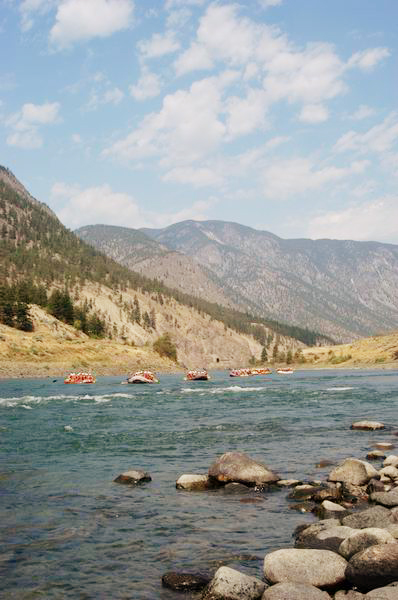
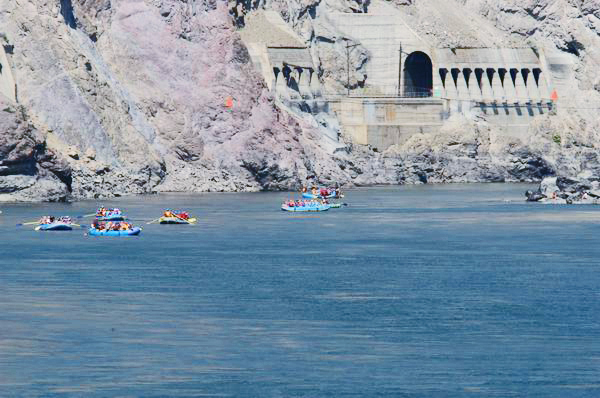
With Hell’s Gate forever etched in my mind, the last set of rapids
on the river passes by without me hardly noticing, and before long we
are cruising towards the take-out site. Lying back on the raft, I gaze
at the canyon walls and deep-blue sky above, letting my mind flow with
the mighty Fraser before being landlocked once again. Rafting these three
incredible waterways has brought me face to face with the immense power
and beauty of Mother Nature’s remarkable system of arteries, and
before our raft pulls into shore, I vow to return here, someday, to challenge
the churning white water once again.
Photography:
If the terrain doesn’t kill you, the raging river will—if
you fall in, that is! Making images of white-water rafting can be a dangerous
affair. Clambering over massive boulders on the way down to the river’s
edge and then across the smaller but more menacing slime-covered stones
along the water can make a widow out of any photographer’s wife.
You’ll have to decide if the awesome images to be had once you get
into position are worth it!
Once you do reach the spot that is “the spot” for super-cool
rafting images, you’ll want to think of a couple of things before
you start blasting away at the rafters. First, rafts move pretty fast,
and they tend to bob up and down all the time. Getting proficient at focusing
on and panning with a moving target is paramount. Whether you’re
using manual or auto focus—I prefer auto—you’ll want
to make sure these two skills are mastered before you consider trying
to shoot any rafting shots that’ll be keepers.
Another important ingredient to add to a white-water rafting shoot is
the ability to nail down a proper exposure in the usually bright sunlight
and glare that lurks in the world of any water-based photographic pursuit.
It’s not nearly as hard as snow or ice, but the glare is there just
the same and must be compensated for if you want to make a good image.
In order to make sure that I always get good exposures along the river,
I follow a couple of simple rules: for one, keep your back into the sun!
And use exposure compensation in the neighborhood of +0.3 to +0.7 EV.
Bracketing like crazy doesn’t hurt either!